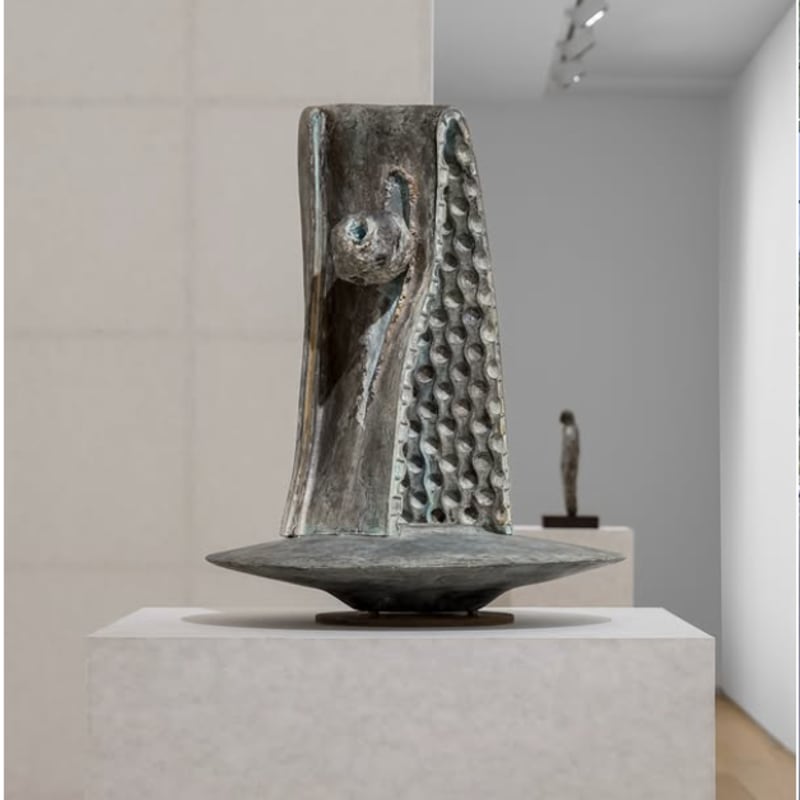This seasonal exhibition features a selection of sculptures by Hans Josephsohn (1920–2012), known for his deeply personal explorations of the human form in works that oscillate between figuration and abstraction. Throughout his career, the Swiss artist developed a unique visual language that conveys a profound sense of presence and timelessness. His sculptures ‘effortlessly command the space around them, yet are elusive, reclusive, withdrawn,’ writes Jackie Wullschläger in the catalogue accompanying Josephsohn’s current exhibition at the Musée d’Art Moderne de Paris, ‘they all have a reserve so deep as to be confrontational.’
This exhibition was realised in collaboration with Georg and Emily von Opel, renowned internationally for their art collecting and cultural philanthropy.

Brass, 12 kg
50 x 28 x 20 cm (19.69 x 11.02 x 7.87 in)

While his works from the 1960s and 1970s are still rooted in figuration, bearing distinguishable facial features and body shapes, from the 1980s onwards, the artist alludes to the body with increasing subtlety. ‘I simply wanted to get to the heart of the matter and didn’t want to be held back by the external impressions of nature,’ Josephsohn has stated.
Untitled, 1969
Brass, 42 kg
73 x 60 x 24 cm (28.74 x 23.62 x 9.45 in)
— Jackie Wullschläger

Josephsohn’s sculptures are defined by a powerful corporeality, but despite the figures’ striking sensuousness, the artist’s tactile treatment of the surface disrupts their representational quality. A testament to the unmediated relationship between Josephsohn’s hands and the forms he sculpted, traces of the artist’s fingermarks are visibly embedded in the works. Crafted from plaster and then cast in brass or bronze – and often left outside, exposed to the elements – his sculptures are raw, with a roughly finished, patinated texture. Since it allowed him to work freely, plaster was his material of choice; he could add, shape and scrape or chisel down throughout the working process. Despite the ‘humanness’ inherent in his works, the rugged surfaces are faintly reminiscent of the natural world, evoking porous rock formations. ‘Josephsohn’s works adopt a geological solidity. His nudes have the presence of a mountain, his heads are so imposing that the air seems denser, while his reliefs, even the smallest ones, act as if they had always been there,’ writes Fabrice Hergott, director and general curator of the Musée d’Art Moderne de Paris.
Untitled (Ruth), 1976
Brass, 60 kg
110 x 57 x 37 cm (43.31 x 22.44 x 14.57 in)


Josephsohn worked primarily from models, and upon completion, he often named his sitters in the titles of his sculptures. Although they are hardly portraits in the conventional sense, bearing no physical resemblances to the model, his works carry the impressions of human contact, conserving a spiritual or mental connection. ‘Hans Josephsohn’s interest in the character of people was of vital significance for his creative work as an artist,’ states Ulrich Meinherz, managing director of the Kesselhaus Josephsohn in St. Gallen, where the artist’s estate is located. ‘As abstract and far removed as his sculptures may be from their natural appearance, the starting point was always the direct individual opposite him.’ Josephsohn’s sensitive perception of his environment gave rise to whole groups of works; his series of reclining figures started in 1965 – one of which is part of the collection of The Metropolitan Museum – was inspired by the image of his girlfriend propped up on a mattress. Taken by the beauty and fragility of the scene, Josephsohn was inspired to depict this subject in his sculptures, a motif he continued until his death.
Untitled, 1971
Brass, 142 kg
66 x 218 x 59 cm (25.98 x 85.83 x 23.23 in)

In Josephsohn’s practice, reliefs play a central role in all phases of his artistic development. He has stated: ‘The reliefs come in some way from life – without meaning to sound too dramatic: they have a personal origin. So when something has happened [in my life], I’ve made reliefs in the atelier. And this has brought me catharsis.’ In contrast to the solitary depictions of individuals in his freestanding sculptures, the scenic surface allowed the artist to place two or three figures in relationship with each other, thus providing a space for Josephsohn’s contemplation on his own experiences of human connection. By adding an almost narrative quality to these explorations of interpersonal interactions, or ‘translations of life situations’ as he called them, they shift between lived experience and fictionalisation. Transcending mere representation, Josephsohn’s approach to sculpture can be understood as a deeply personal investigation of the human condition.
Untitled, 1974
Brass, 64 kg
113 x 66 x 36 cm (44.49 x 25.98 x 14.17 in)
— Fabrice Hergott
























































































































































































